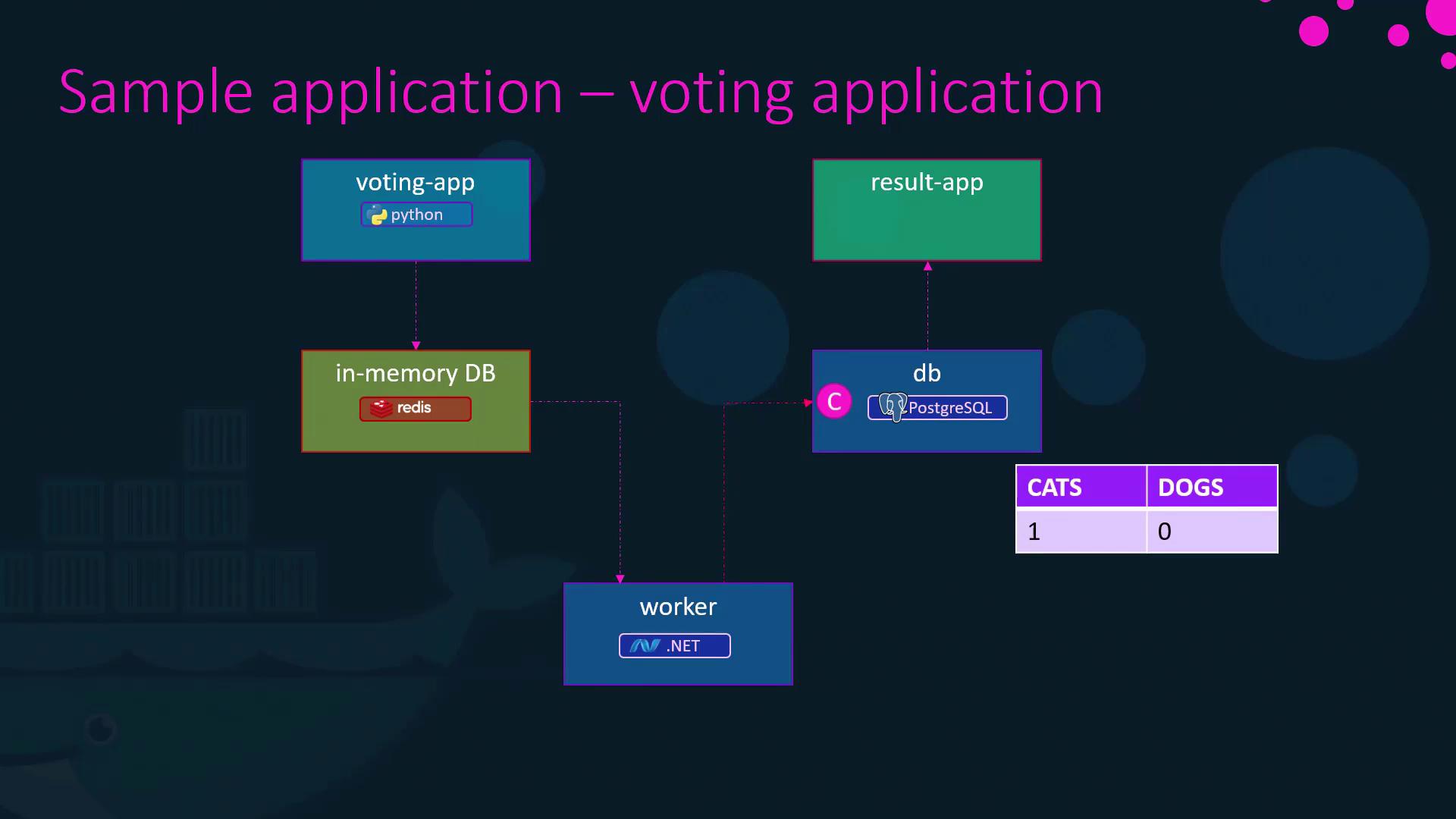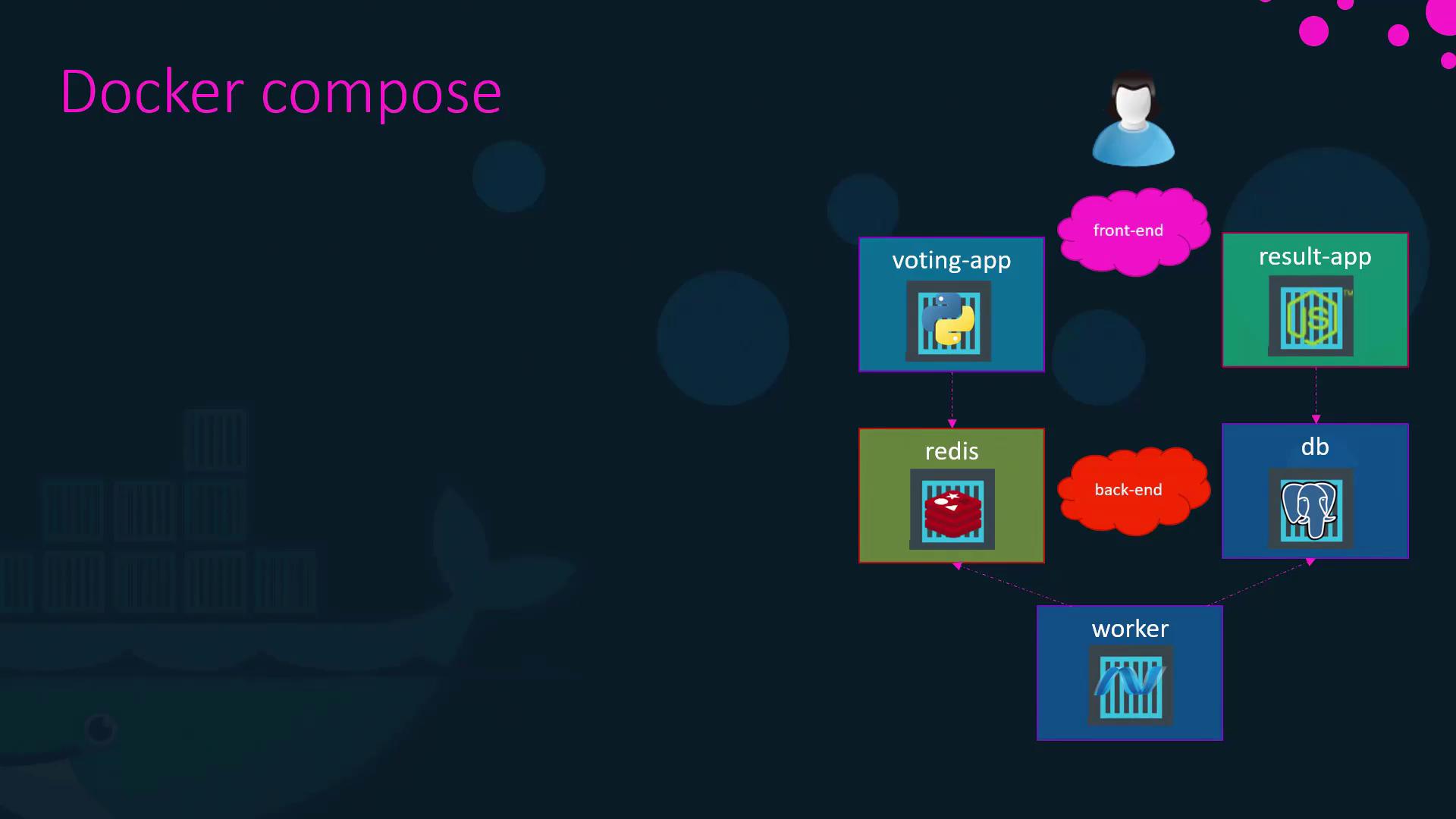Docker Certified Associate Exam Course
Docker Compose
Docker Compose
Docker Compose lets you define and run multi‐container applications from a single YAML file. Instead of managing each docker run command manually, you declare services, networks, and volumes in docker-compose.yaml and launch the entire stack with one command:
docker-compose up
1. Recap: Running Multiple Containers with docker run
To illustrate the complexity of manual container orchestration, imagine starting four services individually:
docker run -d --name web mmumshad/simple-webapp
docker run -d --name database mongo
docker run -d --name messaging redis:alpine
docker run -d --name orchestration ansible
Each container runs, but wiring them together (networking, links, ports) quickly becomes tedious.
2. Defining Services in Compose
In docker-compose.yaml, all services and their options live under the services: key:
version: '3'
services:
web:
image: mmumshad/simple-webapp
database:
image: mongo
messaging:
image: redis:alpine
orchestration:
image: ansible
Then bring the entire stack up:
docker-compose up
Note
Every configuration change is version‐controlled in your Compose file—no more hunting down individual CLI commands.
3. Sample Voting Application Architecture
We’ll demonstrate Compose using Docker’s sample voting app, composed of:
- Voting app (Python web UI): records “cats” or “dogs” votes in Redis.
- Worker (.NET): reads votes from Redis and updates PostgreSQL.
- PostgreSQL: stores persistent vote counts.
- Result app (Node.js web UI): displays tallied results from PostgreSQL.

4. Manual Stack Deployment with docker run
If images already exist on Docker Hub, you might start containers like this:
# Data layer
docker run -d --name redis redis
docker run -d --name db postgres
# Services
docker run -d --name vote -p 5000:80 voting-app
docker run -d --name result -p 5001:80 result-app
docker run -d --name worker worker
However, without networking configuration, containers cannot communicate.
4.1 Linking Containers (Deprecated)
The --link flag creates /etc/hosts entries for cross-container DNS:
docker run -d --name redis redis
docker run -d --name db postgres
docker run -d --name vote -p 5000:80 --link redis:redis voting-app
docker run -d --name result -p 5001:80 --link db:db result-app
docker run -d --name worker --link redis:redis --link db:db worker
In your Node.js code, you’d connect via the hostname db:
pg.connect('postgres://postgres@db/postgres', (err, client, done) => {
if (err) console.error("Waiting for db");
callback(err, client);
});
Warning
Container links are deprecated. Instead, use user‐defined networks as shown in the next sections.
5. From docker run to docker-compose.yaml
Convert your verified docker run commands into a Compose file:
# Working commands for reference
docker run -d --name redis redis
docker run -d --name db postgres:9.4
docker run -d --name vote -p 5000:80 --link redis:redis voting-app
docker run -d --name result -p 5001:80 --link db:db result-app
docker run -d --name worker --link db:db --link redis:redis worker
Compose definition:
version: '2'
services:
redis:
image: redis
db:
image: postgres:9.4
vote:
image: voting-app
ports:
- "5000:80"
links:
- redis
result:
image: result-app
ports:
- "5001:80"
links:
- db
worker:
image: worker
links:
- redis
- db
Launch with:
docker-compose up
6. Building Local Images in Compose
If your service images are built locally, specify a build: context instead of image::
version: '2'
services:
vote:
build: ./vote
ports:
- "5000:80"
links:
- redis
result:
build: ./result
ports:
- "5001:80"
links:
- db
worker:
build: ./worker
links:
- redis
- db
redis:
image: redis
db:
image: postgres:9.4
Compose will build these images from each directory’s Dockerfile before starting the containers.
7. Compose File Versions Compared
Different Compose versions introduce new features and schemas. Refer to this summary:
| Version | Structure | Highlights |
|---|---|---|
| v1 | No services: | Legacy; no networks or depends_on |
| v2 | services: | Built‐in network, depends_on support |
| v3 | Same as v2 | Adds Swarm deployment settings |
Examples
Version 1
version: '1'
redis:
image: redis
db:
image: postgres:9.4
vote:
image: voting-app
ports:
- "5000:80"
links:
- redis
Version 2
version: '2'
services:
redis:
image: redis
db:
image: postgres:9.4
vote:
image: voting-app
ports:
- "5000:80"
depends_on:
- redis
Version 3
version: '3'
services:
redis:
image: redis
db:
image: postgres:9.4
vote:
image: voting-app
ports:
- "5000:80"
For full details, see the Docker Compose file reference.
8. Defining Custom Networks
By default, Compose creates a single bridge network. You can isolate traffic with multiple networks:

version: '2'
services:
redis:
image: redis
networks:
- back-end
db:
image: postgres:9.4
networks:
- back-end
vote:
image: voting-app
networks:
- front-end
- back-end
result:
image: result-app
networks:
- front-end
- back-end
worker:
image: worker
networks:
- back-end
networks:
front-end: {}
back-end: {}
Containers on front-end can only communicate with those also on back-end.
Next Steps
Now that you’ve mastered service definitions, version schemas, and custom networks, try creating and running your own docker-compose.yaml configurations in the exercises below.
Links and References
Watch Video
Watch video content